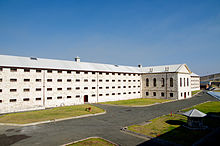Riots at Fremantle Prison
Constructed in the 1850s using convict labor and modeled after Pentonville Gaol, Fremantle Prison served as Western Australia's primary maximum security facility for male offenders.
Despite some reforms prompted by Royal Commissions in 1898−99 and 1911, substantial changes to the prison's operation didn't commence until the 1960s.
A new superintendent with outside experience, Hugh Hann, was appointed, and supported by the newly elected Labor government interested in penal reform.
[6] There was a riot in 1854, after the Roman Catholic chaplain was suspended for accusing his Protestant counterpart of being in league with the devil, and other inappropriate comments.
[11] A prisoner, Charles Street, refused to undertake work breaking stones, as he had not been sentenced to hard labour.
The Sunday Times derided George for conceding to the demands of the mutineers, rather than using "armed force and … the loss of human life if necessary".
The prisoners made a commotion that lasted throughout the night, with "singing, cursing, shouting, … determined that the world should know [of their strike]".
[17] A riot occurred on 4 June 1968, precipitated by the serving of allegedly contaminated food to prisoners the previous evening.
Other factors that contributed were the rudimentary and deplorable state of sanitation and personal cleanliness facilities, tougher sentencing introduced with the Parole Act of 1964 that did not take rehabilitation potential into account, and the overcrowded and purposeless life of many prisoners.
Additional police and wardens arrived at 5 pm, but took seven hours to subdue the prisoners, with the last of them locked in their cells just after midnight.
However, both Director Colin Campbell and the Jail Officers' Union were, in January 1972, worried that overcrowding could result in another riot within six months.
As division 3 prisoners were let inside at around 4 pm, a voice exclaimed "Let's take 'em",[3]: 59 and simultaneously, guards were splashed with boiling water, usually used for making tea.
The prisoners withdrew to the exercise yard, taking 15 hostages, as flames quickly overran the building, spread into the rafters, and caused the roof to collapse.
[9]: 20 The prisoners' leaders made three demands: a meeting with Attorney General Joe Berinson, access to the media, and a guarantee of no retribution afterwards.
[9]: 20 Prisoners did, however, have an opportunity to communicate with the press during the siege, as the riot was a live media event with television helicopters filming from overhead.

